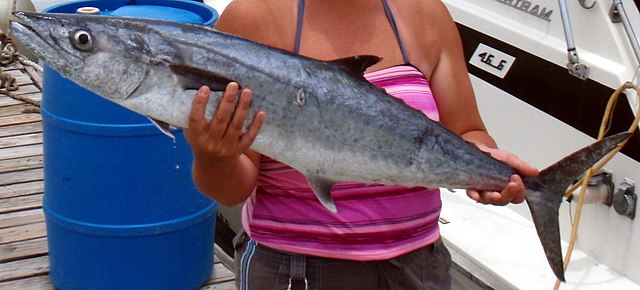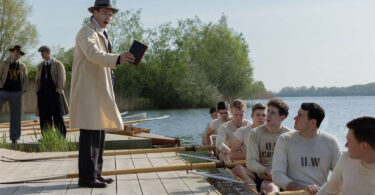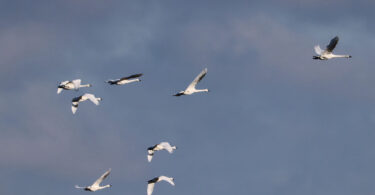Capt. Gordon Churchill
reprinted from Coastal Review.org
The king mackerel is one of the most popular fish species that anglers pursue along the North Carolina coast. With their aggressive nature, willingness to hit almost anything, and ability to make drag screaming runs when first hooked, they are just a bunch of fun.
Because of these qualities, there is a king mackerel tournament somewhere almost every weekend. Plenty of boats head out in pursuit of them from every port, and plenty of tackle dedicated to them is sold in our coastal shops.
Let’s see what a typical day spent in pursuit of these gamesters is like. I talked to one of our local captains to get an idea of how he does it. Really can’t get better advice than talking to the pros.
Let’s start with tackle. Capt. Matt Paylor of Sound-N-Sea Charters in Morehead City likes a 7-foot, live-bait trolling rod with a Shimano TLD reel filled to the brim with 20-pound line. Smaller, school-sized kings eagerly hit trolled spoons and frozen cigar minnows and you can catch a lot of them.
When 10- to 20-pounders are hanging out around a structure, such as artificial reefs, wrecks or ledges, I’ve had great days using spinning gear and casting to them with all kinds of swimming plugs and topwaters. I’ll even use a 10-weight fly rod rigged with a sinking line and a big streamer fly attached to a wire leader.
A 20-pound king mackerel can make a fly reel sing, Paylor said, however, if you want to get the big ones, you have to use live bait. His go-to is live menhaden but he also uses live bluefish in the 2- to 3-pound range.
“You will definitely catch bigger kings with live bait,” he said.
For live bait trolling, tie 15 feet of 30-pound fluorocarbon to the end of your main line, and to that attach a double hook live bait rig made with No. 5 single-strand wire and size 4 “quad strong” treble hooks.
Capt. Matt said that kings are very predictable.
“They are so consistent with their yearly patterns that if you caught them in a spot in previous years, they are probably going to be there again,” he said.
He recommends using a sea surface temperature chart and seeing where the water is hovering in the 70-degree range and starting your day at a reef or wreck in that zone. If you see bait working—and especially if you see kings feeding—give it a serious shot. If you have seen kings feeding in open water, you’ll never forget what it looks like: They skyrocket out of the water like a submarine-launched missile. Put out your lures and baits and keep an eye out for signs of fish.
Paylor said a good rule of thumb is to troll your live baits at around 2 miles per hour. When you get a bite, it’s unmistakable. Normally the rod slams down and the reel starts screaming. Make sure your drag is not set too tightly or it’ll be over.
You’ll get a nice long run when the fish is first hooked. The smaller-sized fish of less than 20 pounds will run out of energy pretty soon. Bigger ones, over 30 pounds, 40 pounds and especially over 50 pounds, won’t tire as readily, and the real monsters may do it a few times before they tire. Keep your drag set light and let the fish do its thing, follow it with the boat if necessary. There’s not a lot for them to get tangled up with out there and most big fish that are lost are due to pulled hooks from a too-tight drag. Besides, hearing that drag sing is the best part of hooking into a trophy-sized fish.
Paylor’s biggest was over 50 pounds, and most people who fish for them often have captured specimens of a similar size. The big ones are out there so treat every bite the same.
He added that if you are catching only sharks, then it’s time to go elsewhere.
A fish (besides sharks) that is the bane of king mackerel anglers is the amberjack. It’s the largest of the jack species that visit us in summer.
If you troll near any high spot, usually the top of a shipwreck, there may be a school of them there. Their detractors call them “reef donkeys” with disdain. That’s because when you are trolling with a carefully prepared trolling rig and putting in hours looking for trophy kings, one of these bad boys can mess you up. Broken lines. Straightened hooks. Tournament anglers especially dislike them. Because it’s an hour or more fighting a fish over 30 pounds that won’t win them any money. That’s a shame really.
When trolling for kings and a school of amberjacks show up in your trolling spread, don’t get mad. Have fun! These fish are a blast and hit topwater plugs with abandon. Cast the soda-bottle-style poppers in the 5- to 6-inch-long range such as the Rapala Magnum Xplode or the Yozuri Bull Pop, retrieve them with a big pull and a pause to make a huge splash and be prepared for an amazing display. Often a group of them will come up together and slash at it with reckless abandon until one finally gets hooked.
Be prepared with a heavy casting rod. Heavy spinning gear or plug casting gear is worth having rigged and ready. I’ve caught them on 12-weight flyrods with the biggest popper I could make. They can show up at any time over any wreck or reef. You just have to be ready. If you’re not fishing in a tournament, why not go have fun with them instead of cursing at them. They will come in fast, hit hard and then keep you occupied for about 20 minutes while they try to pull you out of the boat.
King mackerel are a delight when they are smoked. Brine them in water with an equal amount of sugar and salt for a few hours. Remove the fish from the brine and let them air dry for at least an hour. A slight skin should form. Leave that alone.
Put your smoker on at 170 degrees. You want a good amount of smoke. Use a nice flavorful wood like cherry or apple. Get it nice and smoky. It’s going to take at least three hours and as long as four and a half. It should get a nice dark color with a nice firm edge of even darker meat.
You can shred it up and mix it with cream cheese or mayonnaise or do what I do and eat it like candy. It tends to disappear like that.







